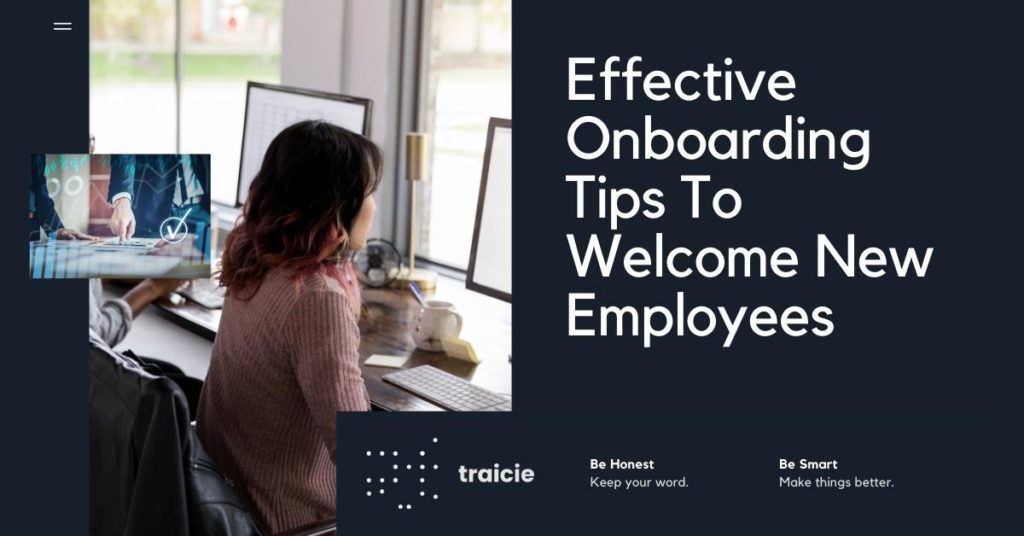What is meant by the employee onboarding process in HR? Which are the 4 phases of onboarding? How do you build a good onboarding process flow, by using templates? In this article, traicie aims to tell you all about what the HR onboarding process is, the stages it constitutes, the reason why the onboarding process is essential for the organization and some useful tips to run the onboarding process successfully.
After weeks of checking many job applicants and running countless interviews, finally the HR professionals hired one job candidate. This is where the employee journey starts and the new employee is excited to see what’s next. One of HR processes is onboarding, helping new hires to get familiar with the company. They need to learn how to work effectively and integrate seamlessly into the organization.
1. What Is Employee Onboarding Process?
What is meant by onboarding in the HR context? It is the integration process that starts as soon as the candidate accepts the job offer. The onboarding process is used to ensure a smooth transition of new employees into their roles and the organization. It is important that the newly hired employees feel a sense of welcome and a sense of engagement from both the HR team and the department that they will work for.

During the onboarding process, the employees gain the knowledge and skills they need to become effective members of their organizations. The term refers to getting a new hire on board and turning them into top-notched company team members.
| >>> You might also want to know more: Cognitive Biases in Recruitment Process, How to avoid it?
Smart recruiters would work systematically during the onboarding process and cover all its angles. Organizations must invest a reasonable amount of time, energy and resources necessary to create onboarding experiences. Here it is important that the onboarding experience makes the organization’s expectations clear. They are meant to introduce organizational culture and make vital interpersonal and organizational connections for an employee to thrive.
It is estimated that approximately 36% of organizations do not have a structured onboarding process in their hiring system. Moreover, about 76% of HR managers believe onboarding is not used up to its full potential, while 57% of those surveyed claimed that lack of manager bandwidth was a barrier to proper onboarding.
These data speak out the alarming truth of not having a quality onboarding process in a great number of organizations. Let’s find out more about onboarding and how traicie fits into the picture!
2. Why is the Employee Onboarding Process Important for Your Organization?
Statistics show that about 4% of new employees quit after the first day. Additionally, 50% of new employees leave their jobs after 4 months. The figure is indeed one of the most critical HR processes to employees’ strong engagement, longevity and successful performance.
Onboarding plays a key role in welcoming new hires and preparing them for their jobs. The purpose is to make a positive contribution to organizational goals and values. During the onboarding process, HR needs to provide new employees with orientation, helping them to understand the jobs. Employees who receive proper onboarding require less training afterward, saving time from other employees and their coach.

Thanks to the onboarding process, new staff will be integrated seamlessly into the organization. It helps build beneficial relationships and attain confidence within the manager and colleagues. When onboarding is done correctly, it shall help reduce stress and increase confidence for new employees.
| >>> Find out: the solution of AI in HR: How does it eliminate hiring bias? benefits and limitations.
If we proceed properly, the onboarding process will be one of the main factors to retain new employees, reduce turnover rate and enhance employee satisfaction. Why do we say so? Let the data show you why!
A major cause of employee turnover is poor onboarding. This can cost a company 100-300% of the total employee’s salary. Moreover, the average cost of hiring an employee to replace the quitting one is around $4,000, according to Glassdoor. A successful onboarding process can help prevent this costly turnover.
If your organization wants to retain employees, it needs to invest in a full-fledged onboarding program to integrate the new employees seamlessly into your company. Then, they will be more likely to stay with you for a long time.
Interestingly, supporting the new employees from Day 1 also gives out a signal that the organization has a healthy corporate culture. Furthermore, running a successful onboarding is a great way of marketing your brand.
3. What are the 4 Phases of Onboarding?
There are 4 sequential stages in the onboarding process. These exist of the pre-onboarding, the first day, the initial development stage and the employee evaluation.
The Pre-onboarding
Pre-onboarding starts when the job candidate accepts the job offer and makes it through their first day. What makes this stage important is the uncertainty factor. Most employees are uncertain during this period because they do not possess a clear vision of what the future holds for them within the company.
During these uncertain times, even the smallest ounce of doubt can lead employees to change their minds not to join the company.
All HR needs to do is to keep the employees posted about their future duties and their managing roles. They should let employees become more familiar with their work environment. Also, HR experts are more likely to help new employees with their paperwork and show some hospitability. For instance, check if the new employee needs help relocating or renting a place to live.

The First Day within the Onboarding Process
The second stage of onboarding begins on the employee’s first day and lasts through their first week. During this stage, what HR should do is help the new employee settle in the organization. As soon as they enter the company, remember to introduce them to your corporate culture, the workstations and other employees.
| >>> You might also wonder about: Recruitment funnel: how to optimize your funnel by creating the right metrics?
According to a recent study, during the first day, hosting a meet-and-greet day is the best way to get this done. Always introduce the new staff to current employees so that they will not feel lost. Most employees may face a problem when becoming part of a team and they may even fear being rejected. Therefore, it is HR that needs to integrate newly hired staff better by doing meets and greets.
What’s more, HR needs to pay attention to the new employees’ management duties during their first day at work, trying to integrate them into the company’s daily flow and explain their obligations thoroughly. Doing so will give the new hire a clear perspective on when, how and what they have to do.
Initial Development in the Onboarding Stage
After the first week of employment, the onboarding stage moves into the initial development phase. It is the migration from a new hire position to a member of a company. This stage usually lasts about 3 months. As soon as you introduce the new employee to the workflow, they shall be ready to be integrated into the company.
HR needs to oversee the overall performance of the new hires. This stage is essential for every business because new employees can set their working tone. It gives out the signal whether they are a good match for your company.
The company shall hold a meeting with the HR manager and encourage them to let the new hire find their way to an official position. It shall be better if the HR manager creates a full-fledged plan on how they see the new employees succeeding.
| >>> Learn more about: How to Hire Based on Soft Skills [Interview Tips]
They can see if their quality changes and if their productivity rate is satisfying. It is not a rare thing that new employees may make mistakes in the initial period at the company and hence, instead of harsh criticism, the HR manager could help newbies find their way more easily and friendly.
Once the first trimester ends, the first results will be in. To compare them, call a meeting with the new employee and the HR manager who helped onboard them.
Employee Evaluations in the Onboarding Stage
Yearly employee evaluation is the last stage of the onboarding process. After a year spent at the company, the new hires need to undergo another evaluation where you will discuss their progress, their future goals and their ambition. It is also suggested to ask your new employees for feedback and opinions. The more confident they are with what they do, the more they will contribute to the success of your company.

What are the 4C’s of Onboarding and How to Implement Them?
| Compliance | Employees learn the basic rules and policies of the organization. Additionally, they fill out all necessary paperwork to Comply with the company rules and regulations. |
| Clarification | Clarify policies, expectations, roles, responsibilities and how the employees’ work contributes to the organization. |
| Culture | Help employees understand the corporate Culture and provide a sense of values, norms and unique language that employees need to know to fit in. |
| Connection | Create connections by fostering interpersonal and organizational relationships for new employees to feel like a part of the team. This is the trickiest one, but the most important, among the 4C’s of the onboarding process. |
How Long Should a Good Onboarding Process Take?
The amount of time it takes to successfully get a new staff onboarded varies based on the company culture and the job requirements, hence, the onboarding process can take a long or short time.
It is generally known that the first day, first week and first trimester are critical times for new employees. The first day determines whether an employee can settle in the company immediately or need more help to bond with colleagues and adjust to the line of work. It will include a new employee’s enthusiasm and responsiveness to the new work environment. Then the first trimester is relevant to monitor because it indicates the employee’s decision to stay in the company and starts setting the working tone for their future obligations.
| >>> Read more: Employee Turnover Rate: 8+ Strategies to Reduce [Updated]
Especially the first six months are when employees learn a lot about their new roles and responsibilities, so if a year of onboarding can be too long for your organization, consider a talent development and onboarding program that may cover at least the first three or six months of the new position. After that period, traicie believes that most newly hired staff will be good on their own to work and add value to the company.
For most technology and enterprise companies, the standard onboarding time for new employees is 3 months. However, most companies’ onboarding process is much shorter, according to the CareerBuilder survey in 2017. Across more than 2,000 HR experts, 72% stated that the length of their employee onboarding time is less than one month.
The onboarding process is not a one-time event, but it continually goes on within the first year of an employee’s new journey until the employee’s first anniversary.
During this onboarding time, new employees integrate themselves into the company culture, ask numerous questions and embark on their learning process about the job and the team.
On the day the new employee celebrates their one year of working, the HR manager should sit down with the employee and discuss their future ideas and goals
Onboarding Tips to Set New Hires up for Success
Build a plan for onboarding new employees and follow it
To cut off the onboarding process on the right foot, HR managers should have a neatly organized onboarding plan, to bring newly hired staff amazing onboarding experiences. The onboarding plan needs to include weekly itineraries, with clearly defined expectations and key learnings.
For the first month, they should outline specific objectives for new talents to thrive in the next following days. Hence new employees can become familiar with the company.

The main benefits of a successful onboarding plan include sharing information about the company tasks and the link between tasks and their assigned experts. Besides, smart AI tools to help employees optimize their daily duties.
Create a checklist to be done, for example:
Be welcoming and supportive
HR experts are more likely to assist new employees with their paperwork, help them understand the corporate culture and introduce them to their hiring manager. It’s better for HR professionals to show a high level of hospitability. For instance, check if the new employee needs help and answer their questions, providing them with constructive feedback for them to grow.
Utilize HR software
In this 21st century with the rapid hi-technology advancement, numerous HR software are available to help you design a better onboarding structure. Onboarding tools are software, resources or training platforms you can use to streamline the entire recruiting process. With an ever-changing work environment of both online and offline working modes, it’s never been more important to have the right onboarding tools in your organization.
SUMMARY
The employee onboarding process is crucial for the success of any organization. It keeps employees engaged and confident to keep working and making a positive contribution to the company. Understanding the onboarding process and knowing how to engage with new employees in each stage of the process enables HR professionals to save time and costs, reduce turnover rat and better promote the company’s brand.
Take traicie’s tips for your onboarding strategy and build on them to ensure a successful career for all new employees.
Do you know that traicie’s sourcing tools for recruiters can help the recruitment team to leverage your onboarding process but also in the strategic operational value of the recruiting process :
- Cost of a job board – Reduce annual spending on job boards
- Cost of HR tools – Reduce the cost of surveys and assessment tools
- Recruitment costs – Reduce selection costs
- Internal mobility – Fill more skilled jobs with internal staff
- Time to hire – Reduce the number of days a role goes unfilled
- Salary costs – Reduce overall salary costs
- Attrition – Reduce the rate of turnover
- Recruitment cost – Reduce the general recruitment cost